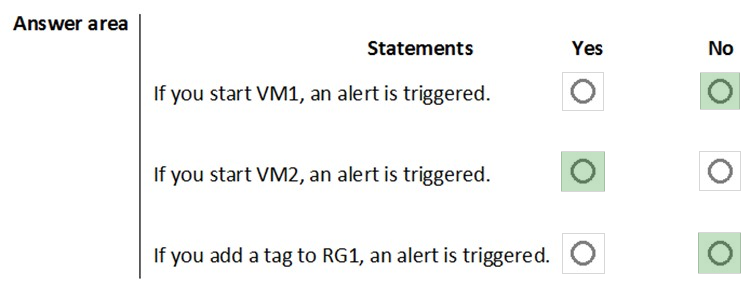

HOTSPOT -
You have an Azure subscription that contains the resources shown in the following table.
VM1 and VM2 are stopped.
You create an alert rule that has the following settings:
✑ Resource: RG1
✑ Condition: All Administrative operations
✑ Actions: Action groups configured for this alert rule: ActionGroup1
✑ Alert rule name: Alert1
You create an action rule that has the following settings:
✑ Scope: VM1
✑ Filter criteria: Resource Type = "Virtual Machines"
✑ Define on this scope: Suppression
✑ Suppression config: From now (always)
✑ Name: ActionRule1
For each of the following statements, select Yes if the statement is true. Otherwise, select No.
Note: Each correct selection is worth one point.
Hot Area:

JAGUDERO
Highly Voted 4 years, 4 months agoLobo
4 years, 1 month agoHot_156
5 months agoITFranz
6 months, 4 weeks agowannabepro789
4 years, 1 month agomadhatter
2 years, 10 months agokhengoolman
3 years, 5 months agokhengoolman
3 years, 5 months agoachechen
1 year, 1 month agoepomatti
1 year, 7 months agoKarls
Highly Voted 3 years, 10 months agoARDNK
3 years, 4 months agoAzureJobsTillRetire
2 years, 7 months agogolitech
Most Recent 6 months, 1 week agogolitech
6 months, 1 week agoxRiot007
11 months, 3 weeks agopentium75
1 year agoShyammmcfy
1 year, 6 months agoepomatti
1 year, 7 months agorosef
1 year, 8 months agowardy1983
1 year, 8 months agowardy1983
1 year, 8 months agoalisyed
1 year, 6 months agowardy1983
1 year, 9 months agoArio
2 years, 1 month agoliorh
2 years, 3 months agomajstor86
2 years, 5 months agokabooze
2 years, 8 months agoFal991l
2 years, 9 months agosomenick
2 years, 10 months ago